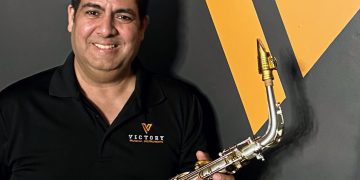 Innovation often gets (mis) interpreted as “fad” – nowhere more so than in the world of musical instruments. Taking that one step further, it’s likely that no group of musicians, as an aggregate, are as stubbornly, immovably rooted in “tradition” as guitarists: “If it’s not the way things were 50 years ago, we don’t like it!” So paved is the road that provides the uphill struggle for any guitar designer or supplier who tries to sell players on self-tuning guitars, “robot” guitars, MIDI interface guitars, and so on.
Innovation often gets (mis) interpreted as “fad” – nowhere more so than in the world of musical instruments. Taking that one step further, it’s likely that no group of musicians, as an aggregate, are as stubbornly, immovably rooted in “tradition” as guitarists: “If it’s not the way things were 50 years ago, we don’t like it!” So paved is the road that provides the uphill struggle for any guitar designer or supplier who tries to sell players on self-tuning guitars, “robot” guitars, MIDI interface guitars, and so on.
It’s all the more impressive, then, that Voyage-Air Guitars (www.voyageairguitar.com) have taken off (pun unintended, but it stays) as they have. eartily embraced by players of all stripes, these revolutionary folding guitars are no gimmick, but rather high quality instruments that successfully address the issue of portability. Now fielding five lines of acoustic and electric guitars at a number of price points, Voyage-Air is poised to make a serious impact on the market.
MMR recently spoke with Michael Ferrucci, Voyage-Air Guitars’ VP of sales & marketing to get the scoop on how these guitars work so effectively, how the company is cracking the market, and what’s on the horizon…
MMR: To start with, can you briefly talk about the origins of Voyage-Air?
Michael Ferrucci: The concept of a full-size folding guitar came from master luthier and world-renowned inlay artist Harvey Leach. With over 35 years experience at making custom acoustic guitars, Harvey has crafted over 400 high-end acoustic and electric guitars that have graced both studio and stage. He responded to customer demand for a compact, yet full-size instrument – one that could travel easily as “carry on” luggage for commercial airliners. He hit on the idea of a guitar that could fold in half, based on a unique patented hinge that locks the neck firmly in place without sacrificing the sound and particularly the ergonomics of the instrument.
Harvey’s decades of experience with design and materials enabled him to bring volume, tone, and resonance to production-based guitars – Voyage-Air models that challenge his own hand-built masterpieces. After years of R&D and prototypes, Voyage-Air began shipping guitars in October 2008.
MMR: Let’s get some vital statistics out of the way – how many people are currently on staff at Voyage-Air and what is the facility like?
MF: We have a core staff of fifteen employees at our Livermore [California] headquarters: Customer Service, Sales and Marketing, two full-time luthiers for guitar assembly, set-up, and warranty repair. We have always maintained a policy of 100 percent QC inspection for each and every guitar before shipping. We also have full-time employees who “telecommute” their expertise in Marketing Communications, Website Design, and Artist Relations from Northern California, Nashville, Alabama, and Michigan. The majority of Voyage-Air employees are lifetime guitar players who know our products, believe in our products, and frequently use them for their own performances.
Voyage-Air Guitar headquarters is in Livermore, California. It’s a 5,000 sq. ft. facility that features computer-controlled temperature, humidity, advanced workstations for guitar assembly and QC, and more. We employ the latest computer database systems to track individual product, shipping, dealer quantity status, and Internet website performance. We are located near the central corridor of the San Francisco Bay Area (45 minutes from San Francisco), which facilitates immediate transport and shipping for critical components and deliveries. Voyage-Air also maintains a satellite headquarters in Nashville. Here, music pros from all over the world can have a “hands on” experience with the full line of Voyage-Air acoustic and electric guitars.
MMR: How much of a challenge is it to “convert” those whose initial impression may be that a folding guitar is inherently – and fundamentally – a gimmick?
MF: People have attempted to make portable guitars before, but it’s never been an instrument like this. This isn’t rocket science: Here we have a guitar that folds in half, opens up, and essentially goes right back to where it was.
The first question that people ask is, “What happens to the strings? What happens to the tuning?” Well, what do you do when you first take your guitar out of the case? You tune it. Same thing here – it’s really not a big deal. Of course the hinge, the latch mechanism, is very important. Our mechanism, which is patented in all sorts of ways, can’t be copied. It’s very finely tuned – no pun intended. They’re precision pieces of machinery.
MMR: I’d imagine that once you get these in people’s hands, the very same qualities that might, at first glance, raise the “gimmick!” red flags, become very strong selling points for dealers.
MF: Our guitar is almost like a magic trick. One of my favorite things to do is to hand the guitar to someone and then if they like it say, “Wait, check this out” and then fold it – their jaws drop. They can’t believe that what they just played and confirmed is a great guitar is now folded in half. It’s such a cool thing for a salesman in a store to create new business. No matter how we market this thing, the bottom line is: in a store where an employee can touch one of our guitars, fold it in half, and then hand it to a customer – it sells itself. It’s a profitable line, there’s no competition, it’s not a joke, it’s not a gimmick, there are professionals playing Voyage-Air guitars.
MMR:How do you help dealers get that message across to that customer who has just walked into the store?
MF: For the dealers we’ve created a POP such that the guitar goes on the wall in the folded position. Any guitar player in his right mind who walks into the store is going to stop dead and say, “What the heck is that?” It’s the perfect opportunity to engage the customer. Our guitar sells itself: One, it works; Two, it’s a perfect opportunity to engage the customer. You can’t do it by saying, “Do you want to see another Dreadnaught? Do you want to see another Strat copy?”
MMR: Describe Voyage-Air’s distribution network.
MF: Historically, Voyage-Air guitars have been sold and shipped directly to the consumer and to our dealer base from our California facility. Telemarketing and occasional field sales calls were the only methodology employed. Today, as of January 2013, we have now assigned a total of twelve independent rep companies that cover the continental United States, Alaska and Hawaii. We are also distributed in Japan, Western Europe and UK and Australia.
MMR: How would an interested dealer go about acquiring the line?
MF: Simply calling the 800 number (800-371-6478) will start the process of entering into a dealership relationship. We are actively seeking both international and domestic dealers. All inquires will be promptly followed up by my professional staff and representatives.
Due to the fact that Voyage-Air has little or no competition, it is unlikely that there would be any product conflict, thus it makes total sense for a music store to carry the Voyage-Air line! All stores will be given free point of purchase fixtures.
MMR:Parting thoughts?
MF: In almost five years of sales to a wide range of customers, Voyage-Air Guitar has over a 99 percent customer satisfaction rate. That’s incredible: our customers take our guitars into the most extreme conditions – camping, hiking, on stage, motorcycling, and more.
Most guitar players are initially skeptical that a folding guitar can match the sound of a traditional guitar. All of our satisfied customers know they have the best of everything: a great sounding, affordable guitar that is lightweight, with a special backpack-style case so they can take their music everywhere.
Again, the dealers are the ones who benefit because they have a story to tell. It’s new and nothing new has happened with guitars for over 100 years.

























